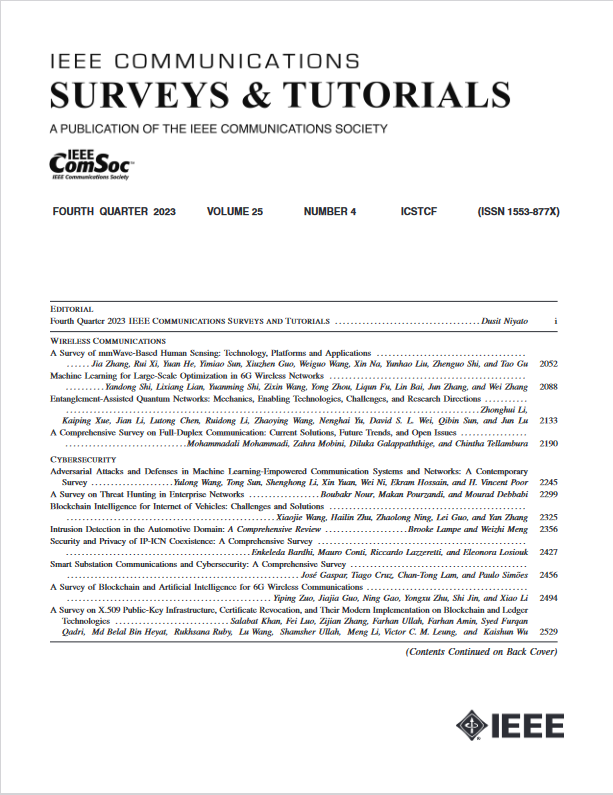网络切片安全调查:攻击、挑战、解决方案和研究方向
IF 34.4
1区 计算机科学
Q1 COMPUTER SCIENCE, INFORMATION SYSTEMS
引用次数: 0
摘要
软化网络的到来使网络切片(NS)成为一项重要技术,可用于分配端到端逻辑网络,以满足第五代(5G)移动网络中新兴应用的各种需求。然而,网络切片的出现也带来了新的安全和隐私挑战,主要涉及网络切片生命周期安全、切片间安全、切片内安全、切片代理安全、零接触网络和管理安全以及区块链安全等方面。因此,增强 NS 的安全性、隐私性和信任度已成为实现 5G 真正功能的关键研究领域。本文对 NS 安全性进行了全面的最新研究。本文阐述了 NS 安全和隐私的分类法,为调查奠定了基础。因此,本文介绍了针对支持 NS 的网络的主要攻击场景。此外,本文还探讨了 NS 安全威胁、挑战和问题,同时阐述了文献中可用的 NS 安全解决方案。此外,还解释了 NS 信任和隐私方面的问题以及可能的解决方案。本文还强调了未来在 NS 安全和隐私方面的研究方向。预计本调查将集中于现有的研究工作,突出研究差距,并阐明未来的研究、开发和标准化工作,以实现 5G 及更先进的移动通信网络中的安全 NS。本文章由计算机程序翻译,如有差异,请以英文原文为准。
A Survey on Network Slicing Security: Attacks, Challenges, Solutions and Research Directions
The dawn of softwarized networks enables Network Slicing (NS) as an important technology towards allocating end-to-end logical networks to facilitate diverse requirements of emerging applications in fifth-generation (5G) mobile networks. However, the emergence of NS also exposes novel security and privacy challenges, primarily related to aspects such as NS life-cycle security, inter-slice security, intra-slice security, slice broker security, zero-touch network and management security, and blockchain security. Hence, enhancing NS security, privacy, and trust has become a key research area toward realizing the true capabilities of 5G. This paper presents a comprehensive and up-to-date survey on NS security. The paper articulates a taxonomy for NS security and privacy, laying the structure for the survey. Accordingly, the paper presents key attack scenarios specific to NS-enabled networks. Furthermore, the paper explores NS security threats, challenges, and issues while elaborating on NS security solutions available in the literature. In addition, NS trust and privacy aspects, along with possible solutions, are explained. The paper also highlights future research directions in NS security and privacy. It is envisaged that this survey will concentrate on existing research work, highlight research gaps and shed light on future research, development, and standardization work to realize secure NS in 5G and beyond mobile communication networks.
求助全文
通过发布文献求助,成功后即可免费获取论文全文。
去求助
来源期刊

IEEE Communications Surveys and Tutorials
COMPUTER SCIENCE, INFORMATION SYSTEMS-TELECOMMUNICATIONS
CiteScore
80.20
自引率
2.50%
发文量
84
审稿时长
6 months
期刊介绍:
IEEE Communications Surveys & Tutorials is an online journal published by the IEEE Communications Society for tutorials and surveys covering all aspects of the communications field. Telecommunications technology is progressing at a rapid pace, and the IEEE Communications Society is committed to providing researchers and other professionals the information and tools to stay abreast. IEEE Communications Surveys and Tutorials focuses on integrating and adding understanding to the existing literature on communications, putting results in context. Whether searching for in-depth information about a familiar area or an introduction into a new area, IEEE Communications Surveys & Tutorials aims to be the premier source of peer-reviewed, comprehensive tutorials and surveys, and pointers to further sources. IEEE Communications Surveys & Tutorials publishes only articles exclusively written for IEEE Communications Surveys & Tutorials and go through a rigorous review process before their publication in the quarterly issues.
A tutorial article in the IEEE Communications Surveys & Tutorials should be designed to help the reader to become familiar with and learn something specific about a chosen topic. In contrast, the term survey, as applied here, is defined to mean a survey of the literature. A survey article in IEEE Communications Surveys & Tutorials should provide a comprehensive review of developments in a selected area, covering its development from its inception to its current state and beyond, and illustrating its development through liberal citations from the literature. Both tutorials and surveys should be tutorial in nature and should be written in a style comprehensible to readers outside the specialty of the article.
 求助内容:
求助内容: 应助结果提醒方式:
应助结果提醒方式:


